Captain Fogel´s life reads like an adventure novel and you need a bit of time to get through his CV of accomplishments. He is an explorer of the old kind, that seems almost extinct today amongst GPS:es and big words. I have gotten to know him just a tiny little bit over the last three weeks, whilst discussing the certain issues within the Explorers Club and he makes me smile all the time. He always seems to be in a good mood and have a whole library full of good stories. So, of course, naturally I begged him to write a story for me and he choose the extra ordinary story about his Expedition down the Omo River in Ethiopia 1973. Enough said from my side, let the story begin!
The Captain’s Log : “The Chief’s Daughter”
By
Captain Joel S. Fogel
“Important events occur in everyone’s life that are the focus of new
directions. These turning points are emotional journeys….they signal
that one way of living is over and a new way is emerging; they are
rites of passage in life.”
Part I — ” The Chief’s Daughter “
It was the Omo River valley in Ethiopia, Africa’s “Hidden Emerald”,
that nearly cost me my life and my sanity.
Do you remember the 1973 fuel shortage, when people stood at the gas
pumps, waiting in anger to fill their tanks ? I suppose it was one of
the first wake-up calls we Americans had regarding our dependance on
foreign oil.
Someone (or a group of someones) had gotten together in Africa and
decided to cut back on the production of that “black gold”. It was the
Organization of African States that had met in Addis Ababa, Ethiopia in
the Fall of that year.
I was there, preparing for an expedition that would change my life
forever. As I ran around looking for supplies and assembling my crew, I
heard rumors of an impending taxi strike in the capital city of Addis.
It always amazes me how things can trigger other things that happen and
you sometimes get caught in the middle. The mystics call it “synergy”
or coincidence. I call it luck.
By the time the strike had struck, I had already flown nearly two
thousand miles south into the jungles of Ethiopia along the banks of
the Omo River to begin an exploration by raft for the purpose of
filming the tribesmen who lived in that region.
I was accompanied by an Ethiopian wildlife expert, Otto Tabebu, and an
German anthropologist, Dieter Hanke. The Smithsonian Institute had
indicated interest in an ethnographic film recording the tribal life in
that area and the Walter Reade Army hospital had taken a pint of my
blood for comparison, following my return.
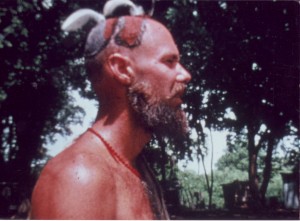
In a sense, I was a human guinea pig. The doctors wanted to sample my
blood again, after I collected specimens of insects for an
entomological survey of disease carrying mosquitoes. River blindness,
malaria, leprosy, and elephantiasis were insect-bourne diseases
reported in the area.
If I contracted something, it would show up in my blood upon analysis
and they would know how to treat it (hopefully).
By the time we had arrived in Mui, the game preserve which bordered the
crocodile-infested, wide, muddy waters known as the Omo River, the
events which would cause Ethiopia’s “Little Giant”, Emperor Halle
Selassie, to be placed under house arrest (after he instigated the oil
embargo which would ironically precipitate his downfall) it was
something we only heard about as we sat around the fire the night
before our historic journey.
We were about to explore a portion of the Omo River Valley for the
first time. It was the upper part of the Great Rift Gorge where famed
anthropologist, Dr. Louis Leakey, had discovered the one
million-year-old “Australopithicus”, the earliest remains of human
kind, several years before our expedition.
The morning of our journey, I woke up to the deep, throaty far-off roar
of a lion. The dry dessert and thorny thickets surrounded us as we
assembled our rowing platform which would sit inside of our 25-foot
rubber raft.
White crates and boxes of food and equipment were scattered near where
the bush plane had dropped us at a make-shift air strip near the river.
The sandy river banks rose thirty feet above the swirling waters of
this ancient waterway, giving it the appearance of a buzz saw cutting
through the desert.
At 29 years old, I was the old man of the group. Tabebu was in his
mid-twenties and Dieter was only 21 years old.
“We must be careful, ” the quiet-spoken Tabebu nearly whispered as we
put the finishing touches on the raft and loaded the gear. “Some of the
crocodiles are as large as the boat and they can turn it over”.
As if to punctuate his comment, a loud slap on the water across the
river, indicated that a huge reptile had just belly-flopped off the
river bank, sliding into the fast-flowing river below.
Mixed emotions accompanied this voyage: there was the anticipation of
the adventure. Fear was a part of the atmosphere as well since we had
heard about warring tribesmen further downstream, and then there was
all of the drama which had led up to our trip on the Omo River.
Originally, I had been part of another expedition led by famed
explorer, Richard Bangs of SOBEK (“The River Gods” and “Riding the
Dragon’s Back” details our explorations of the Omo and the Yangtze
Rivers). We were a group of nearly 20 men and women who had planned to
explore the Omo together.
But tragedy struck: on a preliminary exploration of the Baro River
which flows into the Nile, his rafts were overturned on a waterfall and
one of my friends, Angus McLeod, was drown and lost in the river. I had
broken from the group and set up my own expedition on the Omo.
Now, as we drifted downstream, baking under the equatorial sun, the
sorrow was still fresh although the events were months old.
Gramps used to say, “Joel, never judge an Indian until you’re walked a
mile in his moccasins”.
It’s easy to judge. It’s not always easy to accept.
Here we were in the middle of no-man’s land, collecting insects (and
getting bitten), stopping along the banks to visit small
hunter-gatherer villages of 8-10 people, taking photos and shooting 16
mm film. We traded goods for artifacts which we later donated to the
Smithsonian Museum of African Art.
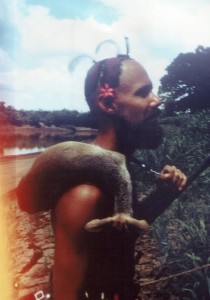
There were four tribal groups: the Karo, the Bume, the Mursi and the
Nidi. All lived naked semi-nomadic lives along the river banks,
traveling inland during the rainy season to tend herds of cattle that
grazed further back, away from the river.
During the dry season, they would return to the Omo River to fish,
raise millet, hunt wilde beast and gather fruits and plants along the
river. It was an idyllic life except for one thing: the tribesmen
fought each other for the land beside the river to cultivate their
crops.
There were regular raiding parties, as we learned, when the tribesmen
would travel across the river, kill members of the other tribes and
even take some of their women as captives and slaves.
During the course of our expedition, I lived with one of these tribes,
the Mursi, following my contraction of vivax malaria. I had been bitten
by a species of Anophiles mosquito which had not heard about the
propholectic medicine known as “chloroquin phosphate” which was suppose
to protect me.
Now as I lay covered with clothes and a blanket, bathed in my own
sweat, hallucinating between bouts of high fever and chills from the
malaria, the two other expedition members determined that they must
leave me in the care of the Mursi. They would cross the river into the
Sudan, hiking to a Swedish Mission which the tribesmen had told them
was a week’s walk away to the west.
I was in misery for over a week, tossing and turning every 48 hours as
waves of nausea and pain racked my body, causing me to lose weight from
dehydration and lack of food. When I came out of it, I was 10 pounds
lighter, but it was not a diet I would recommend for weight loss.
I remember sitting on the riverbank, pointing to objects which were
familiar as Gaddi, a young tribesman who took pity on me, would
pronouce their name. In this way, I was able to form a crude phonetic
vocabulary which helped me to communicate.
One day, I looked at Gaddi and nearly gave him a heart attack when I
put some of my words together to form a phrase and spit it all out at
once: “Keen art te ? Nabasa art te ?” — “Who are you and where are
you going ?”
His large wide grin exposing beautiful white teeth, broke into laughter
as he realized that I could speak his language. I saw a new sign of
respect in his eyes, similar to what I had witnessed living among other
cultures when I learned to communicate in their “tongues” whichthe
tribesmen called language.
It was about this time, several weeks after my recovery, that the chief
of the tribe, Carante Dahoe, invited me to join him in a hunt on the
plains surrounding the village. We were a group of 5 men that morning
as we gathered to face the rising sun. Gun-blued mountains rose in the
distance as we walked through the mist towards them holding our spears
and leather whip shields.
I climbed a bare-limbed Beobob tree and saw a wart hog grazing in the
distance beside some wilde beast. The group fanned out, staying up-wind
and slowly surrounded the wild pig, gradually closing in on him.
We were successful that morning and my spear was the one that stopped
the boar which carried everyone’s spear in it’s back. As a guest, I
was proud to be able to contribute food to these people since a drought
had begun to affect their crops and starvation was beginning to set in
among the river tribes.
We had fed many people with our supplies during the course of the trip.
But eventually, we had run out. Now, waiting for the return of my
expedition members, I depended on what we could catch for food.
It was a scary time, but also very tranquil and beautiful, watching the
sun setting over the plains as the dust rose from herds of elephants
roaming in the distance. Strange…but I was beginning to feel at home
as though I had once before lived in this place.
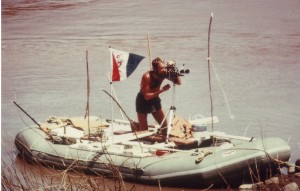
My home in New Jersey was beginning to seem a long way from where I was
at the moment. As for that matter, I had no idea where my partners were
either. I found out later about their odyssey across the desert, their
attempts to return for me and the difficulities they encountered in the
Sudan with the officials at the border.
All of that would come later, for the moment, however, I was seated on
a stool by the riverbank as Carante Dahoe and the rest of the tribe
began my initiation into the Mursi tribe through the shaving of my head
and the placing of mud and clay in my hair.
I recall sitting on that stool for nearly six hours, a rite of passage
to test my will and strength as they wove a piece of bone into my scalp
to make the headdress that would officially make me a tribesmen.
When they were done, they painted the clay cap with blood and water,
giving it a red color. And then they named me “Nogolull”, which
translated to mean “the man who came by water”.
I was given a pair of wart hog sandals, a cloth made from the bark of a
tree which was casually worn over the shoulder and a hut that was built
for me by the tribesmen. It was after all of this, several days later,
that the chief presented me with his 14-year old daughter for a bride.
I explained that I was already married with a child and that my wife in
another place was seven months pregnant with another child. This seemed
to please Dahoe and his son, Gaddi. It was proof of my virility in a
tribe where each man had several wives.
I came to understand that this system of polygamy evolved as a result
of tribal warfare where there were many man killed and many women
without husbands. I also learned that their life expectancy was about
25-30 years, a woman had her first child by 14 years old and 50 percent
of the infants died during, or shortly after child birth.
It was a harsh land.
From the onset, I made it very clear to the chief that although I would
accept his daughter, Kafo, as a bride, she would only be allowed to
come to my hut during the day to help prepare the meals. I could not
take on the responsibility of a new family since I was planning some
day to return to my home in another place.
Kafo had been captured by Dahoe in a raid on the Bume tribe many years
before, several miles downstream. She had all of the markings of a Bume
women, including the scars on her shoulders and a large plate in her
lip which was a sign of beauty.
She wore a gazelle skin skirt with pieces of bone in the hem which made
a light clicking sound when she walked from hut to hut, gathering the
fixings for our meals. Apart from that, she was naked. We all were. It
was hot and that was the way we dressed.
I also learned that the mutilation experienced by the men and women of
the tribe was started during the slave trade period, centuries before,
when the tribesmen learned that if they cut and scarred their bodies,
they would be ugly to the slave traders, their value would be decreased
and they would be left alone with their families. Today, they regard it
as a sign of beauty.
That was something else my travels taught me: that beauty was a
relative thing and definitely in the “eyes of the beholder”. The
tribesmen would chortle with laughter, holding their bellies when I
showed them a fashion magazine displaying Caucasian women, fully
clothed and made up with lipstick, eye shadow and nail polish.
All of this was academic as I stood nearly naked on the Ethiopian
plains beside the Omo River one late afternoon. A small, twin engine
plane had flown low along the river, wing dipping as it passed our
village.
Everyone ran out to the river bank and stared at this great white bird
as it circled the plains, looking for a place to land.
When the pilot arrived, walking towards the village with a member of
the Swedish Mission beside him, their mouths seemed to drop open at the
sight which met his eyes: I was standing beside Kafo in her gazelle
skin skirt, my body, covered with rancid butter the tribesmen used to
keep insects from biting.
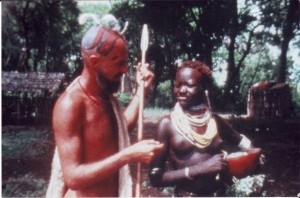
My skin was dark brown from the intense sun, a guinea fowl headdress
sprung forth from my forehead. I wore wart hog sandals, a bark cloth
over my shoulder and a spear and leather shield were in my left hand as
my right hand gently draped Kafo’s shoulder.
“Fogel ?” the bush pilot stammered. “Is that you….Joel Fogel ?“
He didn’t seem too sure and hearing my name pronounced for the first
time in English for such a long time….it took me several moments to
respond with a nod.
” Your friends are waiting for you in Addis. There’s been a terrible
revolution and the communist junta has replaced the government. Sorry
to take so long. Your friends were detained but everything is O.K. now.”
But anyone who knew me during that period in my life will tell you that
everything was not “O.K.” I returned from that jungle a changed man.
A terrible drought struck the Sahil Desert within a year after my
departure. Water holes dried up and million died, including many of my
adopted family by the Omo.
I wandered through the U.N. and Unicef, trying to gain the attention of
those organizations, pleading for the children I had seen beginning to
die. I lectured throughout the country about the same topic. But the
world had it’s attention turned towards oil and the lack of it.
I needed to wait for more than 12 years until 1986, when some of the
film I had shot was combined with a BBC film report on the drought
which had killed millions in Ethiopia. “Band Aid” was born and aid
began to flow into the country. But then came Somolia, the war lords
and all of the trouble the world community had getting food to the
starving in Africa.
Joel S. Fogel has been head of the Environmental Affairs for the Philadelphia Chapter of The Explorers Club for the past 10 years. He also is President of the Waterwatch International and sits on the advisory council of the Atlantic County Utilities Authority’s Groundwater Advisory Committee. This year, Captain Fogel was nominated by ACUA for the CNN Hero of the Year Award for his clean water projects around the globe. The South Jersey native was also nominated this year for The Lowell Thomas Award for humanitarian work in Ethiopia during an anthropological expedition in 1973. His other awards include two Presidential Commendations for environmental work and a Carnegie Hero Award nomination for the rescue of a young woman in 1986 when her car went into the bay on Christmas Eve. Visit his home page here!
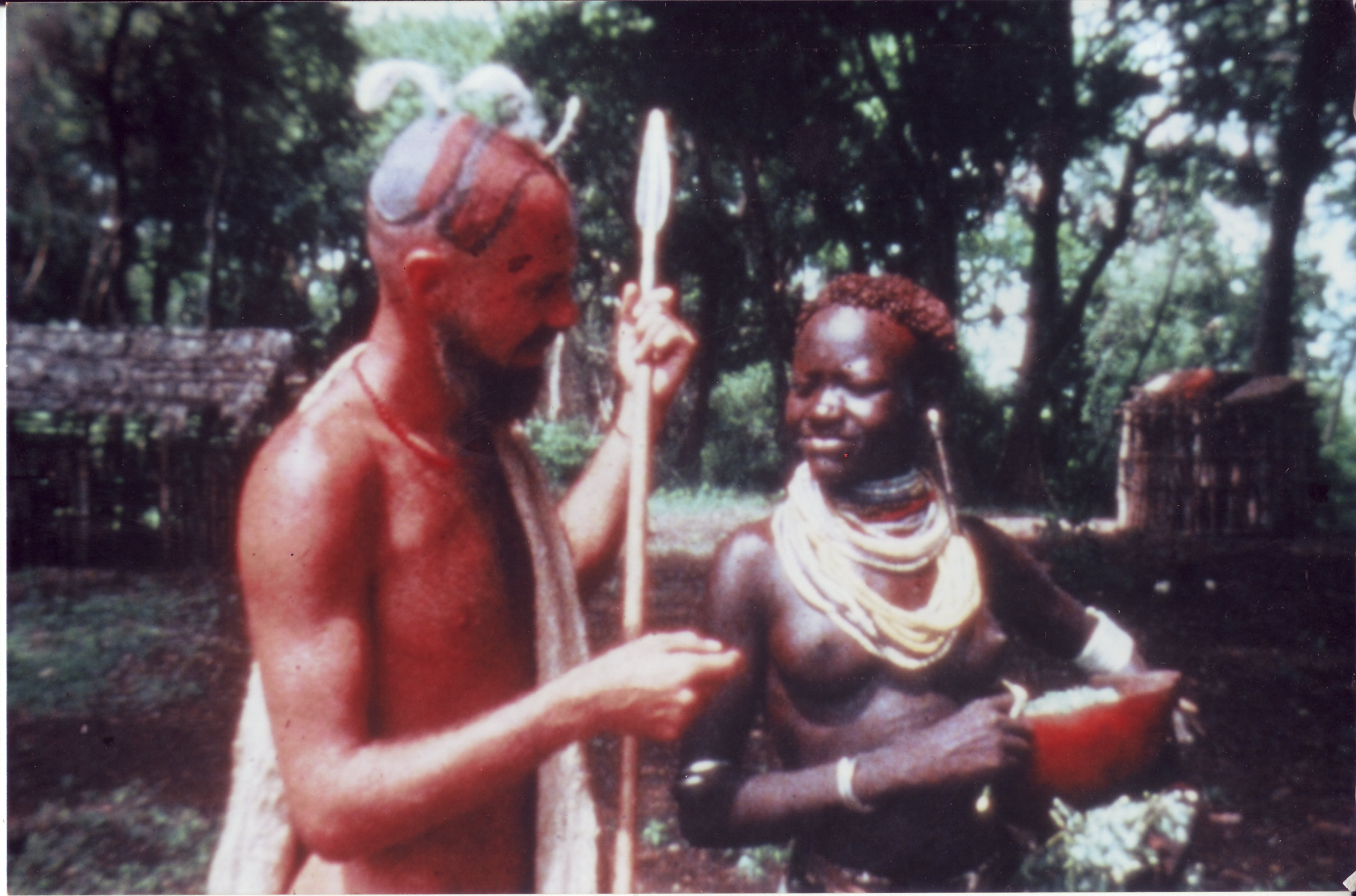


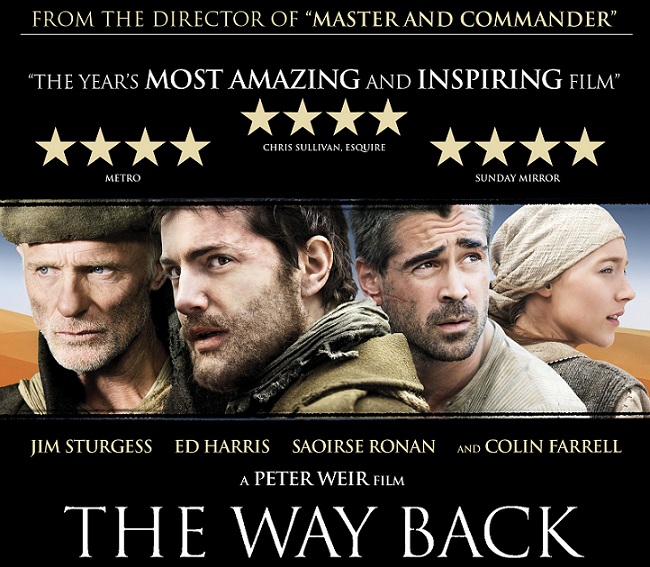
Thanks, Mikael….this is the first time this article was published. Hope that you enjoyed reading my story.
VTY,
Capt. Joel S. Fogel
Your friend in Exploration !